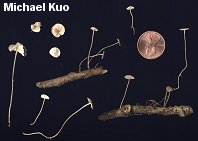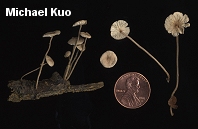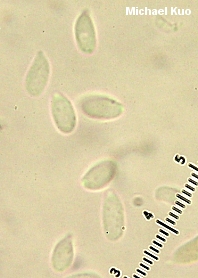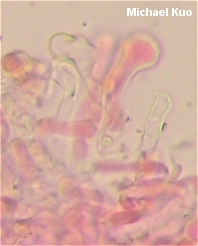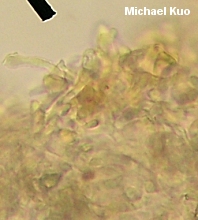| Major Groups > Gilled Mushrooms > Pale-Spored > Marasmioid > Mycetinis opacus |

|
Mycetinis opacus [ Basidiomycetes > Agaricales > Marasmiaceae > Mycetinis . . . ] by Michael Kuo Here is a very tiny marasmioid mushroom found on twigs and sticks of various trees in the eastern United States and in the Southwest. Descriptions of Mycetinis opacus are hard to come by, and it's a bit difficult to identify, but its distinctive features include the small, slightly wrinkled, pale brownish cap that soon fades to buff; the lack of a distinctive odor; the presence of cream colored to tan rhizomorphs in the substrate; and microscopic features (see below). The rhizomorphs are not always present, but when they're in evidence they are distinctive; see the lower-right stick after enlarging the top illustration. Mycetinis opacus (formerly known as Marasmiellus opacus) usually grows on small sticks and twigs, but is occasionally found on leaf litter. Description: Ecology: Saprobic; primarily found on sticks and twigs of great rhododendron, eastern hemlock, and oaks but sometimes reported on leaves and petioles; usually growing gregariously; summer and fall; widely distributed east of the Great Plains, but also recorded from Arizona. Cap: 3-15 mm across; convex, becoming broadly convex, flat, or flat with a slightly uplifted margin; dry; finely granular when young but usually bald by maturity; slightly and shallowly wrinkled; light grayish brown when very young but soon fading to buff or nearly white, with or without a brownish center. Gills: Attached to the stem; whitish; not discoloring; nearly distant, or distant. Stem: Up to 60 mm long; 0.5-1.5 mm thick; fragile; equal; dry; finely hairy to minutely velvety; buff to very pale brown; base often attached, underneath the substrate, to threadlike, brownish or buff rhizomorphs. Flesh: Thin; insubstantial. Odor and Taste: Odor usually not distinctive, but occasionally strong and unpleasant; taste not distinctive. Spore Print: White. Microscopic Features: Spores 6-11 x 3-4.5 µ; smooth; pip-shaped or ellipsoid; inamyloid. Pleurocystidia absent. Cheilocystidia to about 35 x 10 µ; more or less clavate to cylindric, or irregular; often lobed; sometimes with knoblike or fingerlike projections. Pileipellis a tightly packed cutis; terminal cells primarily lobed and irregular, without or with only a few projections--but near the cap margin, terminal cells diverticulate with many fingerlike projections. REFERENCES: (Berkeley & M. A. Curtis, 1849) A. W. Wilson & Desjardin, 2005. (Saccardo, 1887; Desjardin, Gordon & Petersen, 1993.) Herb. Kuo 06140301, 05260404, 07070804. This site contains no information about the edibility or toxicity of mushrooms. |
© MushroomExpert.Com |
|
Cite this page as: Kuo, M. (2013, January). Mycetinis opacus. Retrieved from the MushroomExpert.Com Web site: http://www.mushroomexpert.com/mycetinis_opacus.html |
